USS Colorado (BB-45)
|
||||||||||||||||||||
|
||||||||||||||||||||
|
||||||||||||||||||||
|
||||||||||||||||||||
|
||||||||||||||||||||
The USS Colorado was a battleship of the US Navy and the first ship of the Colorado class (alternatively also Maryland class after the first finished ship). It entered service in 1923 and was used in the Pacific War. After the war it was decommissioned and scrapped. Numerous devotional objects are exhibited in museums in the USA and especially in the eponymous state of Colorado .
history
From commissioning to war


The USS Colorado entered service with the US Navy in 1923 and then embarked on its maiden voyage from New York to Europe. There the ship visited ports in England, France and Italy. She was then assigned to the Pacific Fleet. She visited ports in Samoa , Australia and New Zealand . In 1933 the ship helped in the Long Beach earthquake . In June and July 1937 she helped find the missing pilot Amelia Earhart .
Pacific War
The USS Colorado was repairing the Puget Sound Naval Shipyard in Washington state during the attack on Pearl Harbor in December 1941 . The work was completed at the end of March 1942. Then the ship was turned off for defensive tasks and used to patrol against possible further Japanese advance attempts.
In 1943 the ship supported the US landing companies with its artillery during the Battle of the Gilbert Islands . It carried out similar tasks in early 1944 during the landings on Eniwetok and Kwajalein .
Further landings were supported at the Battle of Saipan and the Battle of Tinian . The Japanese defenders were deeply embedded and well prepared for the attack. Despite heavy preparatory fire from the sea and from the air, many of the hidden guns on the island could not be destroyed. When the USS Colorado was supposed to cover the landing of Marines on July 24th, the ship approached within about three kilometers of the coast. A hidden Japanese battery with heavy 20 cm guns opened fire on the battleship, scoring 22 hits, causing severe damage, killing 43 sailors and wounding 198 others. Despite a list of 17 ° to starboard on the ship supported the landing. On board three 12.7 cm guns, an aircraft catapult, two 40 mm and two 20 mm guns were damaged or destroyed. A week after the repairs were completed, she was hit by two kamikaze aircraft, killing 19 sailors and wounding 72.
She helped with further landings and was mistakenly hit by several 127 mm shells off Mindoro in January 1945 and had 18 dead and 51 wounded.
She ended her war effort with the operation against Okinawa and patrolled the Japanese home islands.
After the war until it was scrapped
The ship first returned to San Francisco on September 20, 1945 and then participated in the repatriation of US troops from Hawaii to their homeland. It was decommissioned on January 7, 1947 and sold for scrapping in July 1959.
See also
Web links
- "Colorado III (BB-45)" at Naval History and Heritage Command
Individual evidence
- ↑ a b c d e Naval History and Heritage Command: Colorado III (Battleship No. 45). In: Dictionary of American Naval Fighting Ships. Naval History and Heritage Command, February 18, 2016, accessed February 20, 2020 (American English).
- ↑ George A. Larson: "A Seabee's Story," Merriam Press, 2012, ISBN 978-1-300-13801-3 , pp. 132 and 133

